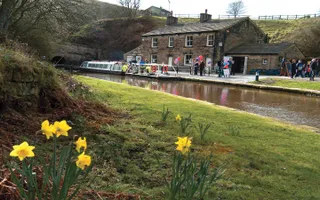Tunnels were traditionally built by plotting out the route across the hilltop and then sinking down several shafts. Miners would then begin digging in both directions from the bottom of the shafts – and from the tunnel entrances. The idea was of course, that they would meet in one perfectly straight line. Unfortunately this did not always happen and some canal tunnels have obvious kinks in them, notably Barnton and Saltersford on the Trent & Mersey Canal.
Some tunnels passed through relatively shallow hills and were later opened out – Armitage (the oldest, on the Trent & Mersey) and Fenny Compton on the Oxford were later replaced by cuttings. Some tunnels were subject to subsidence and collapsed – notably the first Harecastle (Trent & Mersey) and Butterley, on the Cromford Canal. One of the longest – Strood, on the Thames & Medway Canal, was later converted to a railway tunnel.
Many longer tunnels had no towpaths, and boats had to be legged through, while the horse was drawn along a path over the tunnel to its far end. Some employed tugs to pull boats, notably the second Harecastle Tunnel between 1914 and 1954. The last tunnel of the canal age, at Netherton, had towpaths on both sides. The longest towpathed tunnel which can be walked through safely is probably Chirk, 459 yards long, on the Llangollen Canal.
Blisworth Tunnel
Blisworth Tunnel, in Northamptonshire, is one of the longest in Britain. 3076 yards long and broad enough for two narrowboats to pass, it is surpassed only by Standedge Tunnel (on the Huddersfield Narrow Canal) and Dudley Tunnel in the Black Country near Birmingham.
Building Blisworth Tunnel, was the most troublesome part of the Grand Junction Canal's (now known as the Grand Union Canal) construction. When work began, in 1793, the building of a 3km tunnel was a major feat of engineering with no mechanical aids beyond the basic picks, shovels and wheelbarrows available. To add to their basic problems, just three years into the project the navvies hit quicksand. All work had to be abandoned and a new course begun.
Once built, Blisworth had a tunnel tug until 1936.
Longest, deepest and highest canal tunnel
The longest, deepest, and highest canal tunnel in the country is Standedge Tunnel on the Huddersfield Narrow Canal. The tunnel took 17 years to build at considerable cost of life - with the final section being overseen by renowned engineer Thomas Telford in 1811. The tunnel is 196 metres (645 feet) above sea level, runs for just under three and a half miles and burrows 194 metres (638 feet) underneath the Pennines.
This article has been edited with kind assistance from Joseph Boughey




